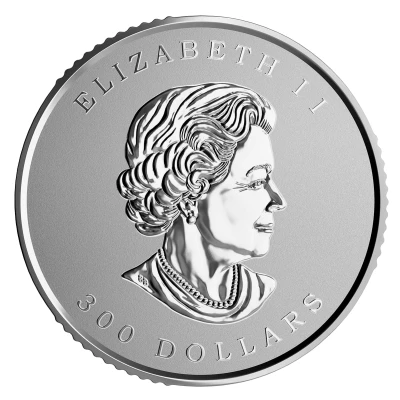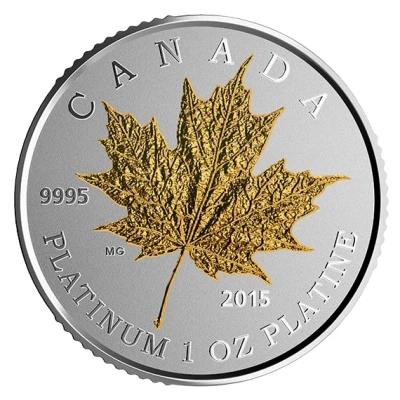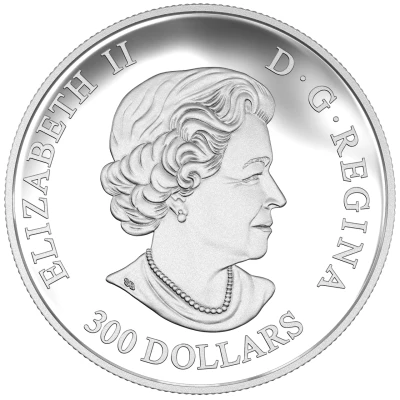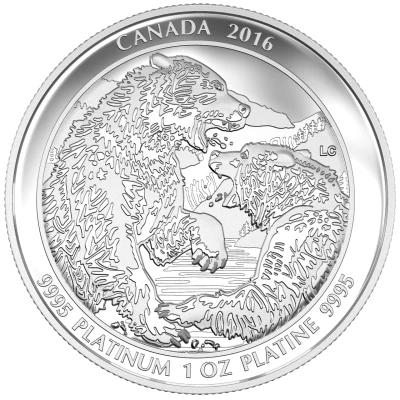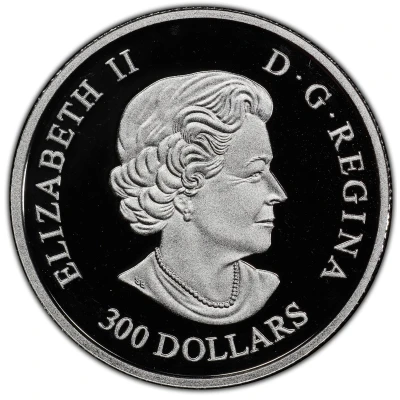
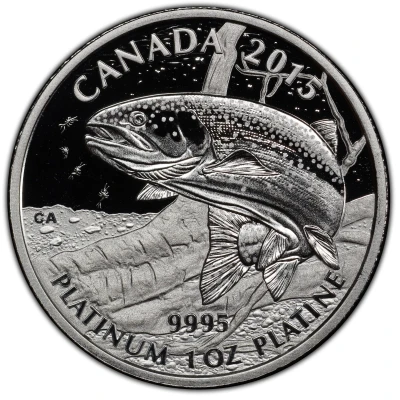

300 Dollars - Elizabeth II Rainbow Trout
2015 year| Platinum (.9995) | 31.15 g | 30 mm |
| Issuer | Canada |
|---|---|
| Queen | Elizabeth II (1952-2022) |
| Type | Non-circulating coin |
| Year | 2015 |
| Value | 300 Dollars 300 CAD = USD 222 |
| Currency | Dollar (1858-date) |
| Composition | Platinum (.9995) |
| Weight | 31.15 g |
| Diameter | 30 mm |
| Thickness | 2.5 mm |
| Shape | Round |
| Technique | Milled |
| Orientation | Medal alignment ↑↑ |
| Updated | 2024-10-04 |
| Numista | N#342062 |
|---|---|
| Rarity index | 100% |
Reverse
Designed by Canadian artist Curtis Atwater, your coin presents a portrait of a rainbow trout in its natural habitat. The image centres around the rainbow trout, viewed from its left side. The front of its body is angled toward the viewer while its tail curls behind it and to the left in the background. This presentation highlights the trout's unique torpedo-shaped body withsmall head, characteristic speckling, and shaded stripe along its side. The fish hovers near a fallen tree branch, which fills the background, in a shallow, gravel-bottomed river.
Script: Latin
Lettering:
CANADA 2015
CA
9995
PLATINUM 1 OZ PLATINE
Designer: Curtis Atwater
Edge
Reeded
Comment
Known for its penchant to leap and fight on the line, the rainbow trout is one of Canada's most popular fish species among anglers.A native of the Pacific Basin, including parts of Asia and North America from Alaska to northern Mexico, Oncorhynchus mykiss is a popular game fish that has been introduced in many non-native locales across Canada and around the world. This beautiful species, though quite diverse in appearance depending on its habitat and diet, is normally green in colour with a spotted back and bright pink streak onits side.
This member of the salmon family averages from 50 centimetres to just under 80 centimetres in length, weighing about 3.6 kilograms—but can reach very large sizes (up to 1.2 metres and 24 kilograms) under the right conditions. Its preferred natural habitat is gravel-bottomed, cool rivers and streams or lakes withsufficient vegetation for predatory coverage. Rainbow trout require fast-moving gravel-bottomed streamsfor spawning. Generally, river dwellers are not as large as lake dwellers.
Rainbow trout are strong predators that feed on water and land insects, small fish, and crustaceans. They are subdivided into about fifteen sub-species, including steelhead, which are the salt-water variety of rainbow trout. Steelhead bear genetic variations that allow them to adapt to life in salt water—a process known as smoltification. They are born in fresh water and return to their birthplace to spawn after undergoing this physiological adaptation to salt water. They are also iteroparous, which means they can spawn several times over their lifetime. Unlike their freshwater cousins, they are entirely silver incolour.
Did you know…
• To spawn, female rainbow trout dig a small depression in the gravel bottom of a poolin a shallow, fast-moving stream. To dig this smallnest, the trout turns on her side and uses her tailto clear the depression from the riverbed. As she releases several thousand eggs into the gravel, a male fertilizes them. She then covers the fertilized eggs with gravel to keep them safe until they hatch between one and two months later.
• Rainbow trout are particular favourites of fly-fishing anglers.
• Rainbow trout have sharp upper teeth but no lower teeth.
Packaging:
Your coin is encapsulated and presented in a Royal Canadian Mint-branded maroon clamshell with a graphic beauty box.
Interesting fact
The Rainbow Trout coin features a unique colorization technique that creates a lifelike representation of the fish's iridescent scales.
Price
| Date | Mintage | VG | F | VF | XF | AU | UNC |
|---|---|---|---|---|---|---|---|
| 2015 | 200 | - | - | - | - | - | - |
Values in the table are based on evaluations by sales realized on Internet platforms. They serve as an indication only for 300 Dollars - Elizabeth II (Rainbow Trout) 2015 coin.
